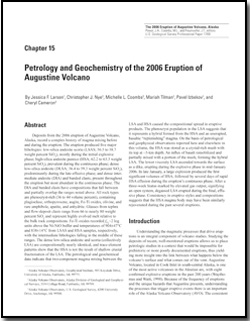U.S. Geological Survey Professional Paper 1769, Chapter 15
Abstract
Deposits from the 2006 eruption of Augustine Volcano, Alaska, record a complex history of magma mixing before and during the eruption. The eruption produced five major lithologies: low-silica andesite scoria (LSAS; 56.5 to 58.7 weight percent SiO2), mostly during the initial explosive phase; high-silica andesite pumice (HSA; 62.2 to 63.3 weight percent SiO2), prevalent during the continuous phase; dense low-silica andesite (DLSA; 56.4 to 59.3 weight percent SiO2), predominantly during the late effusive phase; and dense intermediate andesite (DIA) and banded clasts, present throughout the eruption but most abundant in the continuous phase. The DIA and banded clasts have compositions that fall between and partially overlap the ranges noted above. All rock types are phenocryst-rich (36 to 44 volume percent), containing plagioclase, orthopyroxene, augite, Fe-Ti oxides, olivine, and rare amphibole, apatite, and anhydrite. Glasses from tephra and flow-deposit clasts range from 66 to nearly 80 weight percent SiO2 and represent highly evolved melt relative to the bulk rock compositions. Fe-Ti oxides recorded fO2~2 log units above the Ni-NiO buffer and temperatures of 904±47°C and 838±14°C from LSAS and HSA samples, respectively, with the intermediate lithologies falling in the middle of these ranges. The dense low-silica andesite and scoria (collectively LSA) are compositionally nearly identical, and trace-element patterns show that the HSA is not the result of shallow crustal fractionation of the LSA. The petrological and geochemical data indicate that two-component magma mixing between the LSA and HSA caused the compositional spread in eruptive products. The phenocryst population in the LSA suggests that it represents a hybrid formed from the HSA and an unerupted, basaltic ”replenishing“ magma. On the basis of petrological and geophysical observations reported here and elsewhere in this volume, the HSA was stored as a crystal-rich mush with its top at ~5-km depth. An influx of basalt remobilized and partially mixed with a portion of the mush, forming the hybrid LSA. The lower viscosity LSA ascended towards the surface as a dike, erupting during the explosive phase in mid-January 2006. In late January, a large explosion produced the first significant volumes of HSA, followed by several days of rapid HSA effusion during the eruption’s continuous phase. After a three-week hiatus marked by elevated gas output, signifying an open system, degassed LSA erupted during the final, effusive phase. Consistency in eruptive styles and compositions suggests that the HSA magma body may have been similarly rejuvenated during the past several eruptions. Appendixes 1–5These appendixes are in digital form and consist of additional descriptions and compositional data for samples used in this study. They consist of spreadsheet documents provided in several file formats.
|
Back to The 2006 Eruption of Augustine Volcano, Alaska For additional information contact: Part of this report is presented in Portable Document Format (PDF); the latest version of Adobe Reader or similar software is required to view it. Download the latest version of Adobe Reader, free of charge. |
Larsen, J.F., Nye, C.J., Coombs, M.L., Tilman, Mariah, Izbekov, Pavel, and Cameron, Cheryl, 2010, Petrology and geochemistry of the 2006 eruption of Augustine Volcano, chapter 15 of Power, J.A., Coombs, M.L., and Freymueller, J.T., eds., The 2006 eruption of Augustine Volcano, Alaska: U.S. Geological Survey Professional Paper 1769, p. 335-382 and spreadsheets.